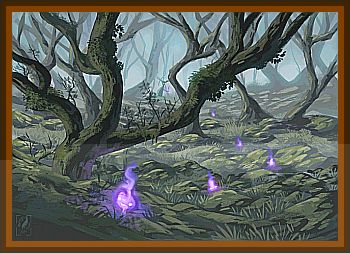

In European folklore, these lights are believed to be spirits of the dead, fairies, or a variety of other supernatural beings which attempt to lead travelers to their demise.Sometimes the lights are believed to be the spirits of unbaptized or stillborn children, flitting between Heaven and Hell.
In Sweden, the will-o'-the-wisp represents the soul of an unbaptized person trying to lead travellers to water in the hope of being baptized.
Danes, Finns, Swedes, Estonians, Latvians, Lithuanians, and Irish people and amongst some other groups believed that a will-o'-the-wisp also marked the location of a treasure deep in ground or water, which could be taken only when the fire was there.
Sometimes magical tricks, and even dead man's hand, were required as well, to uncover the treasure.
In Finland and several other northern countries, it was believed that early autumn was the best time to search for will-o'-the-wisps and treasures below them.
It was believed that when someone hid treasure, in the ground, he made the treasure available only at the Saint John's Day, and set will-o'-the-wisp to mark the exact place and time so that he could come to take the treasure back.
For then he could be fulfilled with treasures.
The Aarnivalkea, in Finnish mythology, are spots where an eternal flame associated with will o' the wisps burns. They are claimed to mark the places where faerie gold is buried.
They are protected by a glamour that would prevent anyone finding them by pure chance.
However, if one finds a fern seed from a mythical flowering fern, the magical properties of that seed will lead the fortunate person to these treasures, in addition to providing one with a glamour of invisibility.
Since in reality the fern produces no flower and reproduces via spores under the leaves, the myth specifies that it blooms only extremely rarely.